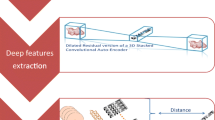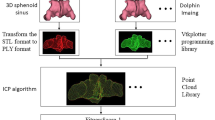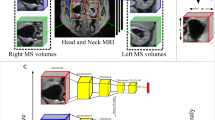Abstract
Human identification plays a significant role in the investigations of disasters and criminal cases. Human identification could be achieved quickly and efficiently via 3D sphenoid sinus models by customized convolutional neural networks. In this retrospective study, a deep learning neural network was proposed to achieve human identification of 1475 noncontrast thin-slice CT scans. A total of 732 patients were retrieved and studied (82% for model training and 18% for testing). By establishing an individual recognition framework, the anonymous sphenoid sinus model was matched and cross-tested, and the performance of the framework also was evaluated on the test set using the recognition rate, ROC curve and identification speed. Finally, manual matching was performed based on the framework results in the test set. Out of a total of 732 subjects (mean age 46.45 years ± 14.92 (SD); 349 women), 600 subjects were trained, and 132 subjects were tested. The present automatic human identification has achieved Rank 1 and Rank 5 accuracy values of 93.94% and 99.24%, respectively, in the test set. In addition, all the identifications were completed within 55 s, which manifested the inference speed of the test set. We used the comparison results of the MVSS-Net to exclude sphenoid sinus models with low similarity and carried out traditional visual comparisons of the CT anatomical aspects of the sphenoid sinus of 132 individuals with an accuracy of 100%. The customized deep learning framework achieves reliable and fast human identification based on a 3D sphenoid sinus and can assist forensic radiologists in human identification accuracy.



source code is open to access. Conv: convolution layer. BN: batchnorm layer. ReLU: activation layer (relu-activation). Max pool: max-pooling layer. Global ave pool: global average pooling layer


Similar content being viewed by others
References
Disaster Victim Identification (DVI). International Criminal Police Organization.https://www.interpol.int/en/How-we-work/Forensics/Disaster-Victim-Identification-DVI. Accessed 26 Sept 2021.
Culbert WL, LAW, F. M. (1927) Identification by comparison of roentgenograms: of nasal accessory sinuses and mastoid processes. J Am Med Assoc 88(21):1634–1636
Yoshino M et al (1987) Classification system of frontal sinus patterns by radiography. Its application to identification of unknown skeletal remains. Forensic Sci Int 34(4):289–99
Tatlisumak E et al (2007) Identification of unknown bodies by using CT images of frontal sinus. Forensic Sci Int 166(1):42–48
Gibelli, Daniele, et al. "Relationship between sphenoid sinus volume and accessory septations: a 3D assessment of risky anatomical variants for endoscopic surgery." The Anatomical Record 303.5 (2020): 1300–1304.
Gibelli, Daniele, et al. "Relationship between sphenoid sinus volume and protrusion of internal carotid artery and optic nerve: a 3D segmentation study on maxillofacial CT-scans." Surgical and Radiologic Anatomy 41.5 (2019): 507–512.
Beaini TL et al (2015) Human identification through frontal sinus 3D superimposition: pilot study with cone beam computer tomography. J Forensic Leg Med 36:63–69
Auffret M, Garetier M, Diallo I, Aho S, Ben Salem D (2016) Contribution of the computed tomography of the anatomical aspects of the sphenoid sinuses to forensic identification. J Neuroradiol 43:404–414
Deloire L et al (2019) Post-mortem X-ray computed tomography (PMCT) identification using ante-mortem CT-scan of the sphenoid sinus. J Neuroradiol 46(4):248–255
Dedouit F et al (2007) Virtual anthropology and forensic identification: report of one case. Forensic Sci Int 173(2):182–187
Ruder TD et al (2011) Radiologic identification of disaster victims: a simple and reliable method using CT of the paranasal sinuses. Eur J Radiol 81(2):e132–e138
Cappella A, Gibelli D, Cellina M et al (2019) Three-dimensional analysis of sphenoid sinus uniqueness for assessing personal identification: a novel method based on 3D–3D superimposition. Int J Legal Med 133:1895–1901. https://doi.org/10.1007/s00414-019-02139-5
Cicero M et al (2016) Training and validating a deep convolutional neural network for computer-aided detection and classification of abnormalities on frontal chest radiographs. Invest Radiol 52(5):281–287
Gonzalez G et al (2018) Disease staging and prognosis in smokers using deep learning in chest computed tomography. Am J Respir Crit Care Med 197(2):193–203
Deng W et al (2019) Brain tumor segmentation based on improved convolutional neural network in combination with non-quantifiable local texture feature. J Med Syst 43(6):152
Spampinato C et al (2017) Deep learning for automated skeletal bone age assessment in X-ray images. Med Image Anal 36:41–51
Li Y et al (2019) Forensic age estimation for pelvic X-ray images using deep learning. Eur Radiol 29(5):2322–2329
Miki Y et al (2017) Classification of teeth in cone-beam CT using deep convolutional neural network. Comput Biol Med 80:24–29
Zhou Y et al (2019) Digital whole-slide image analysis for automated diatom test in forensic cases of drowning using a convolutional neural network algorithm. Forensic Sci Int 302:109922
Souadih K, Belaid A, Salem DB, Conze PH (2020) Automatic forensic identification using 3D sphenoid sinus segmentation and deep characterization. Med Biol Eng Compu 58(2):291–306
Fastuca, R., Lorusso, P., Lagravère, M. O., Michelotti, A., Portelli, M., Zecca, P. A., ... & Caprioglio, A. (2017). Digital evaluation of nasal changes induced by rapid maxillary expansion with different anchorage and appliance design. BMC Oral Health, 17(1), 1-7.
Hang Su, Subhransu Maji, Evangelos Kalogerakis, Erik Learned-Miller, "Multi-view convolutional neural networks for 3D shape recognition", Proceedings of ICCV 2015
Wang J et al (2010) Extensions of the sphenoid sinus: a new classification. Neurosurgery 66(4):797
Li S, Wang Z, Xian J (2010) Study of variations in adult sphenoid sinus by multislice spiral computed tomography. Zhonghua Yi Xue Za Zhi 90(31):2172
Tomovic S et al (2013) High-resolution computed tomography analysis of variations of the sphenoid sinus. J Neurol Surg B Skull Base 74(2):82–90
Štoković N et al (2016) Sphenoid sinus types, dimensions and relationship with surrounding structures. Annals of Anatomy - Anatomischer Anzeiger 203:69–76
Unal B et al (2006) Risky anatomic variations of sphenoid sinus for surgery. Surg Radiol Anat 28(2):195–201
Ruder TD et al (2016) Comparative radiologic identification with CT images of paranasal sinuses – development of a standardized approach. Journal of Forensic Radiology and Imaging 7:1–9
Brun CN et al (2017) Comparative radiologic identification with standardized single CT images of the paranasal sinuses—evaluation of inter-rater reliability. Forensic Sci Int 280:81–86
Bewes J et al (2019) Artificial intelligence for sex determination of skeletal remains: application of a deep learning artificial neural network to human skulls. J Forensic Leg Med 62:40–43
Nassar DEM, Ammar HH (2007) A neural network system for matching dental radiographs. Pattern Recogn 40(1):65–79
Author information
Authors and Affiliations
Corresponding authors
Ethics declarations
Ethics approval
This was a retrospective study; the study sample was obtained from previously available medical materials, in order to avoid unnecessary or additional radiation exposure to the patients. The present study was performed with the approval of the ethics committee of the West China Second University Hospital of Sichuan University, and the code of the ethical approval is KS2021507. Informed consent was waived because this was a retrospective study.
Conflict of interest
The authors declare no competing interests.
Additional information
Publisher's note
Springer Nature remains neutral with regard to jurisdictional claims in published maps and institutional affiliations.
Rights and permissions
About this article
Cite this article
Wen, H., Wu, W., Fan, F. et al. Human identification performed with skull’s sphenoid sinus based on deep learning. Int J Legal Med 136, 1067–1074 (2022). https://doi.org/10.1007/s00414-021-02761-2
Received:
Accepted:
Published:
Issue Date:
DOI: https://doi.org/10.1007/s00414-021-02761-2




